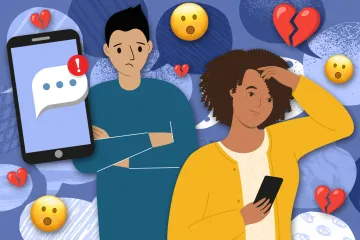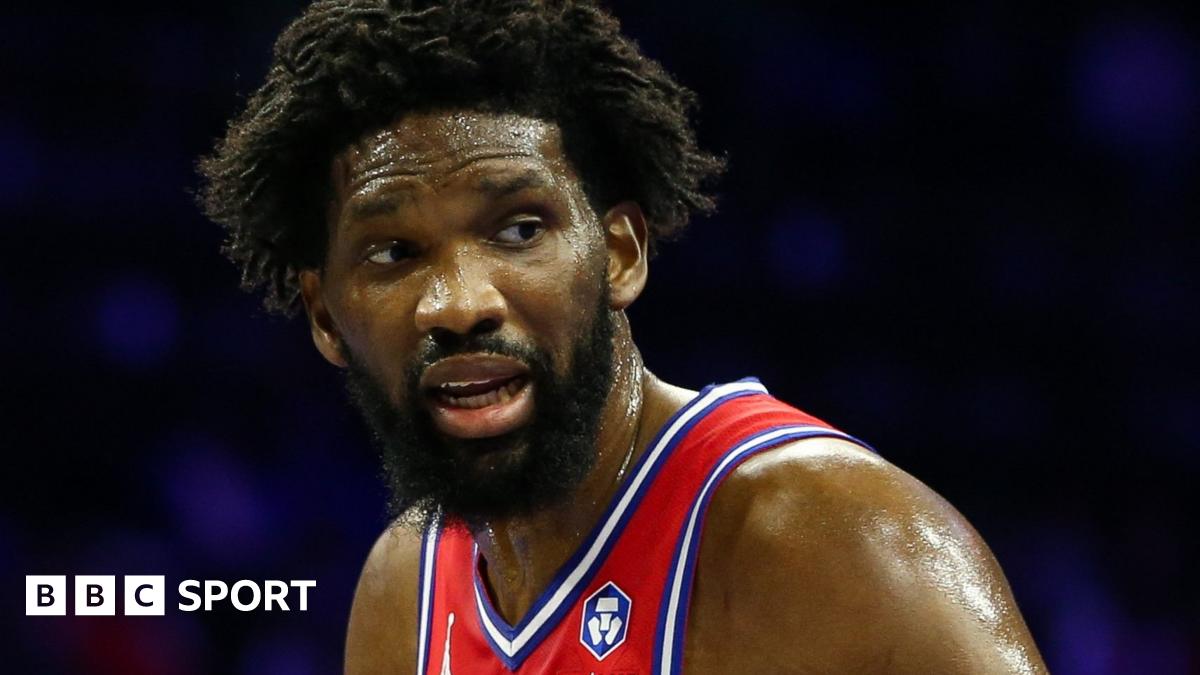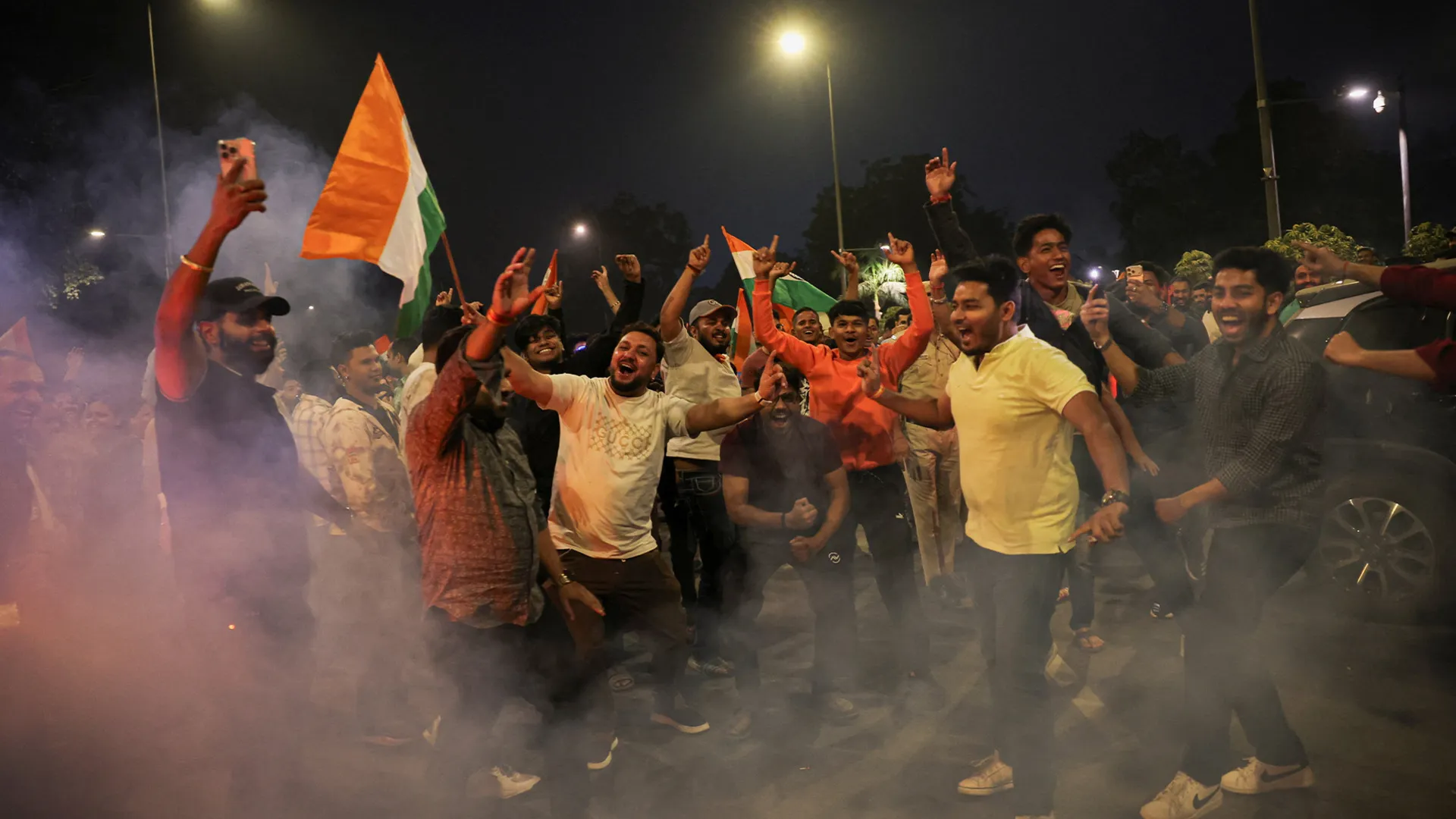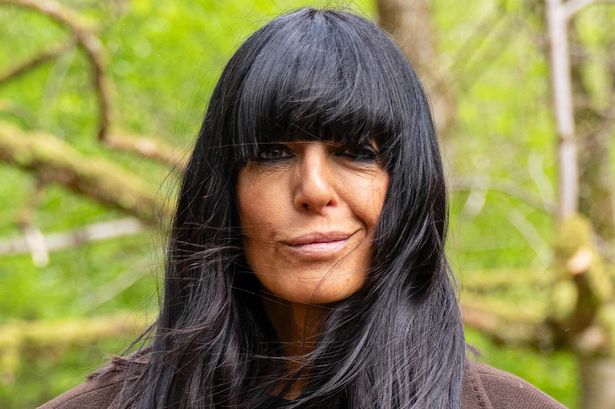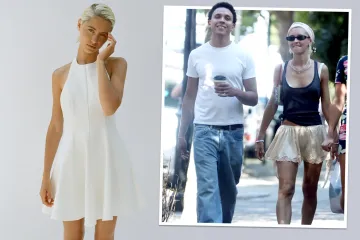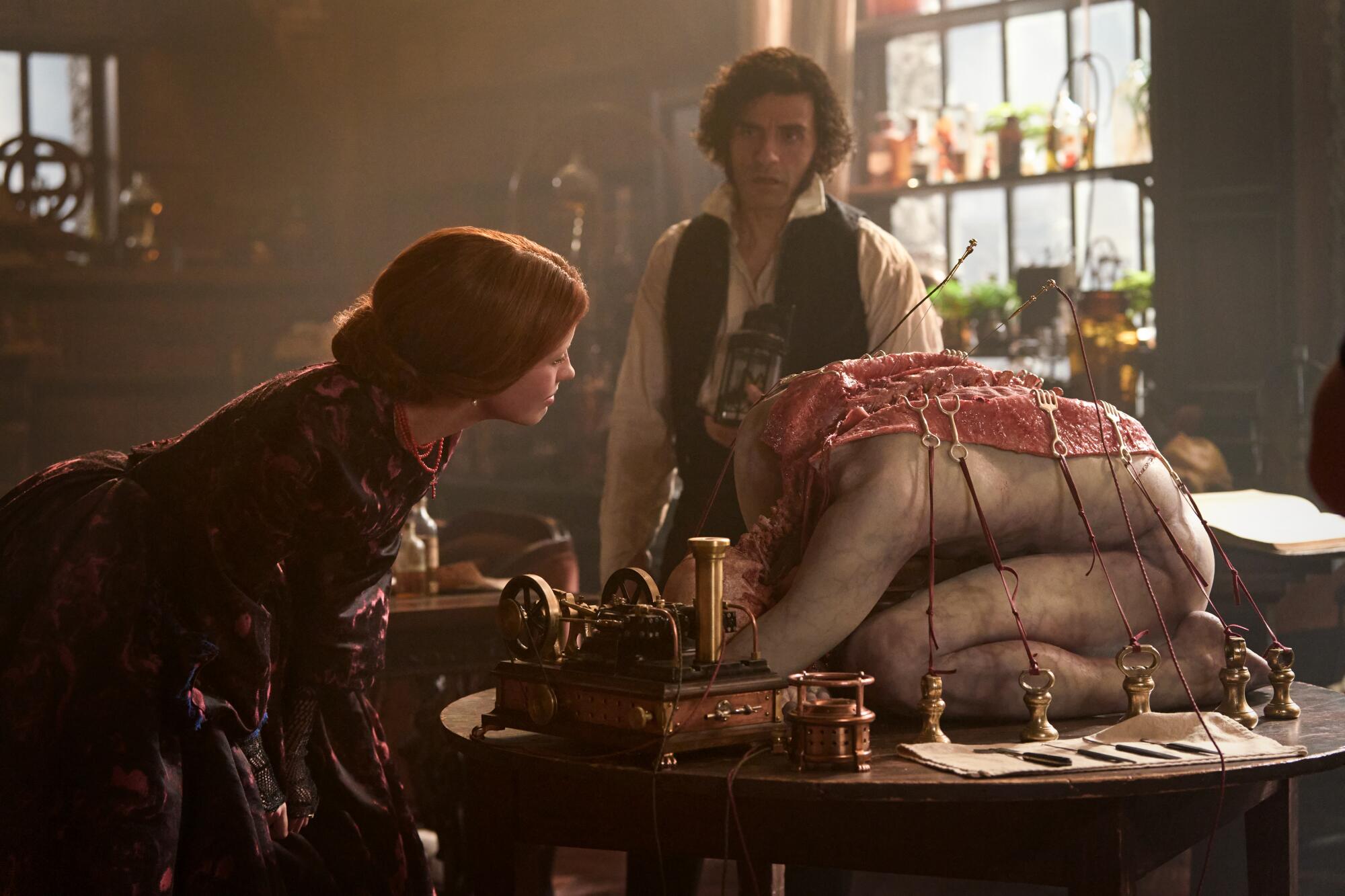Narendra Modi leads tributes to women’s cricket team after World Cup win | Cricket News
India is celebrating after winning a first women’s World Cup title, drawing comparisons to the men’s memorable 1983 triumph.
Published On 3 Nov 2025
Prime Minister Narendra Modi led the tributes to India’s women cricketers following their “historic” triumph in the World Cup final on Sunday, while team captain Harmanpreet Kaur hoped it would be a watershed moment for the women’s game in the country.
After suffering heartbreak in the final of the 2005 and 2017 editions of the 50-overs showpiece, India beat South Africa by 52 runs to secure their first title in front of 40,000 delirious home fans at Navi Mumbai’s DY Patil Stadium.
Recommended Stories
list of 4 itemsend of list
Three defeats in a row earlier in the tournament had nearly derailed India’s campaign before they bounced back to storm into the semifinals, where they pulled off a record chase to eliminate seven-time champions Australia.

‘Dream big and chase those dreams’
“The team showed exceptional teamwork and tenacity throughout the tournament. Congratulations to our players,” Prime Minister Modi said on social media. “This historic win will motivate future champions to take up sports.”
The Indian cricket board announced the team would receive a reward of 510 million Indian rupees ($5.8m) for their title triumph, a victory which the Indian Express newspaper termed “Herstoric” on its front page.
Harmanpreet said it could be a turning point for the women’s game in the cricket-mad country.
“We have been talking about this for many years – we’ve been playing good cricket, but we had to win one big tournament,” the batter said.
“Without that, we couldn’t talk about change. At the end of the day, fans and the audience want to see their favourite team win.
“It’s not that we weren’t playing good cricket, but we were waiting badly for this moment, and today we got a chance to live it.”
The fairytale triumph of the Indian men’s team at the 1983 World Cup is considered the catalyst for the country’s rise to becoming a powerhouse of the game, both on and off the pitch, and batting great Sachin Tendulkar said Sunday’s win was “a defining moment in the journey of Indian women’s cricket”.
“1983 inspired an entire generation to dream big and chase those dreams,” he wrote on social media.
“Today, our women’s cricket team has done something truly special. They have inspired countless young girls across the country to pick up a bat and ball, take the field and believe that they too can lift that trophy one day …”
Mithali Raj, who led India to the 2017 women’s final, said the victory for Harmanpreet’s side had made her dreams come true.
“I’ve seen this dream for over two decades, to watch the Indian women lift that World Cup trophy,” she wrote on X.
“Tonight, that dream finally came true. From the heartbreak of 2005 to the fight of 2017, every tear, every sacrifice, every young girl who picked up a bat believing we belong here, it all led to this moment.”
A spectacular win by the Indian team in the ICC Women’s Cricket World Cup 2025 Finals. Their performance in the final was marked by great skill and confidence. The team showed exceptional teamwork and tenacity throughout the tournament. Congratulations to our players. This…
— Narendra Modi (@narendramodi) November 2, 2025
Jennifer Aniston goes Instagram official with boyfriend Jim Curtis in adorable birthday post
JENNIFER Aniston has confirmed her relationship with Jim Curtis in an adorable Instagram post.
The Friends actress, 56, took to her social media grid to upload a snap showing her hugging her wellness coach boyfriend from behind.
The sultry black and white image showed the pair with beaming smiles, with Jennifer seen peeking over his shoulder.
In her caption, she simply wrote: “Happy Birthday my love.
“Cherished.”
She finished off her super-sweet upload with a red Emoji love heart.
read more jennifer aniston
Real Housewives star Kyle Richards posted two love hearts in reply, while model Poppy Delevingne added the word: “Heaven.”
The relationship reveal came just weeks after the Marley and Me star flashed her rock hard abs in a glam new photoshoot.
The chick flick actress has been rumoured to be in a relationship with Jim Curtis, a hypnotist and wellness expert, since earlier this summer.
At the time, the pair were pictured on a yacht in Mallorca in July.
Recently, the loved-up couple were snapped on a double date at Nobu restaurant in Malibu, California.
The couple were set up by mutual friends.
This is the first time Jennifer has gone public with a boyfriend since her split from husband Justin Theroux in 2017.
LOVED UP
The pair’s relationship has been put under the spotlight of late.
“They are being super private but have been spending a lot of time together,” an unnamed source told Us Weekly.
“They are happy and really into each other.”
The source added: “They’ve been hanging out a lot, but very much on the DL at her home in L.A… it’s very Zen, and she has always been very much into that. They’re a good match.”
Jennifer has been dropping hints that the pair are an item, including ‘liking’ many of Jim’s Instagram posts since May, including one about “a divorce, breakup or difficult romance.”
Jim then returned the favour on her May 25 post of a photo dump that included an image of his book, Shift: Quantum Manifestation Guide.
The wellness guru has described his journey to becoming a hypnotist, saying it started with healing himself.
“After battling with a chronic illness for over 30 years, I learned how to heal and recover from the mental and physical pain it left me with,” Jim writes on his website.
“Through doing the inner work, I not only changed my life, but I’ve helped thousands of others break free from their past to create an entirely new, empowered reality.”
Jennifer, 56, first met ex-husband and fellow actor, Justin in 2007, before beginning their relationship in 2011.
They married in 2015, announcing their split two years later and their subsequent divorce.
Recently, the screen star bravely opened up on her attempts to have a baby for 20 years.
Joel Embiid: Philadelphia 76ers centre fined again by NBA for ‘lewd gesture’
Philadelphia 76ers centre Joel Embiid has been fined $50,000 (£38,000) by the NBA, external for what the league determined to be a “lewd gesture” on the court.
The incident occurred during Philadelphia’s 109-108 loss to the Boston Celtics on Friday when Embiid, 31, scored while getting fouled and then made a chopping gesture to his groin.
Embiid has been fined for the gesture on multiple previous occasions.
In a post on X,, external which also contained the NBA’s social media post detailing his sanction, Embiid appeared to suggest the gesture was similar to a signal that officials make when calling a foul for blocking.
He said: “Yall better start fining the refs for doing the ‘lewd’, ‘blocking foul’ gesture since I’m not allowed to do it.”
Cameroon-born Embiid did not play in Sunday’s 129-105 victory over the Brooklyn Nets, sitting out the match as he continues to manage his recovery from a knee injury which required surgery earlier this year.
Indian cricket fans celebrate first Women’s World Cup title | Cricket
Cricket fans have been celebrating across India after the women’s team claimed their first ever World Cup, defeating South Africa in the final in Mumbai.
Published On 3 Nov 2025
Trump says ‘days numbered’ for Venezuela’s Maduro | News
The US president sent mixed signals over his plans for Venezuela as his military build-up in the Caribbean continues.
Published On 3 Nov 2025
President Donald Trump has sent mixed signals over the potential for a United States military intervention in Venezuela, as he dismissed talk of “war” but threatened the South American country’s leader.
During a CBS interview, released on Sunday, the president warned that President Nicholas Maduro’s days are numbered. The comment came amid a build-up of US military units in the Caribbean, where the US has conducted multiple strikes on alleged drug-trafficking vessels that UN officials and scholars say are in clear violation of US and international law.
Recommended Stories
list of 4 itemsend of list
Asked if the US was going to war against Venezuela, Trump replied: “I doubt it. I don’t think so.”
However, when asked if Maduro’s days as president were numbered, the president replied: “I would say yeah. I think so.”
US media outlets have reported that Washington is planning strikes on military installations in Venezuela as part of its war against “narco-terrorism”.
Trump appeared to deny that he is planning attacks inside Venezuela, although he did not rule the idea out completely.
“I wouldn’t be inclined to say that I would do that,” he said. “I’m not going to tell you what I’m going to do with Venezuela.”
Maduro, who faces indictment in the US on drug trafficking charges, has accused Washington of using a drug offensive as a pretext for “imposing regime change” in Caracas to seize Venezuelan oil.
The US military has carried out more than a dozen strikes on vessels in the Caribbean and the Pacific in recent weeks, killing at least 65 people. The campaign has prompted criticism from governments across the region.
UN human rights chief Volker Turk and rights groups say the attacks, which began in early September, amount to “extrajudicial killings” even if they target known traffickers.
Washington has yet to make public any evidence that its targets were smuggling narcotics or posed a threat to the US.
Can Hollywood survive the rise of AI-generated storytelling?
At a Starbucks in downtown Culver City, Amit Jain pulls out his iPad Pro and presses play. On-screen, one of his employees at Luma AI — the Silicon Valley startup behind a new wave of generative video tools, which he co-founded and now runs — lumbers through the company’s Palo Alto office, arms swinging, shoulders hunched, pretending to be a monkey. Jain swipes to a second version of the same clip. Same movement, same hallway, but now he is a monkey. Fully rendered and believable, and created in seconds.
“The tagline for this would be, like, iPhone to cinema,” Jain says, flipping through other uncanny clips shared on his company’s Slack. “But, of course, it’s not full cinema yet.” He says it offhandedly — as if he weren’t describing a transformation that could upend not just how movies are made but what Hollywood is even for. If anyone can summon cinematic spectacle with a few taps, what becomes of the place that once called it magic?
Luma’s generative AI platform, Dream Machine, debuted last year and points toward a new kind of moviemaking, one where anyone can make release-grade footage with a few words. Type “a cowboy riding a velociraptor through Times Square,” and it builds the scene from scratch. Feed it a still photo and it brings the frozen moment to life: A dog stirs from a nap, trees ripple in the breeze.
Dream Machine’s latest tool, Modify Video, was launched in June. Instead of generating new footage, it redraws what’s already there. Upload a clip, describe what you want changed and the system reimagines the scene: A hoodie becomes a superhero cape, a sunny street turns snowy, a person transforms into a talking banana or a medieval knight. No green screen, no VFX team, no code. “Just ask,” the company’s website says.
For now, clips max out around 10 seconds, a limit set by the technology’s still-heavy computing demands. But as Jain points out, “The average shot in a movie is only eight seconds.”
Jain’s long-term vision is even more radical: a world of fully personalized entertainment, generated on demand. Not mass-market blockbusters, but stories tailored to each individual: a comedy about your co-workers, a thriller set in your hometown, a sci-fi epic starring someone who looks like you, or simply anything you want to see. He insists he’s not trying to replace cinema but expand it, shifting from one-size-fits-all stories to something more personal, flexible and scalable.
“Today, videos are made for 100 million people at a time — they have to hit the lowest common denominator,” Jain says. “A video made just for you or me is better than one made for two unrelated people. That’s the problem we’re trying to solve… My intention is to get to a place where two hours of video can be generated for every human every day.”
It’s a staggering goal that Jain acknowledges is still aspirational. “That will happen, but when the prices are about a thousand times cheaper than where we are. Our research and our engineering are going toward that, to push the price down as much as humanly possible. Because that’s the demand for video. People watch hours and hours of video every day.”
Scaling to that level would require not just faster models but exponentially more compute power. Critics warn that the environmental toll of such expansion could be profound.
For Dream Machine to become what Jain envisions, it needs more than generative tricks — it needs a built-in narrative engine that understands how stories work: when to build tension, where to land a joke, how to shape an emotional arc. Not a tool but a collaborator. “I don’t think artists want to use tools,” he says. “They want to tell their stories and tools get in their way. Currently, pretty much all video generative models, including ours, are quite dumb. They are good pixel generators. At the end of the day, we need to build general intelligence that can tell a f— funny joke. Everything else is a distraction.”
The name may be coincidental, but nine years ago, MIT’s Media Lab launched a very different kind of machine: Nightmare Machine, a viral experiment that used neural networks to distort cheerful faces and familiar cityscapes into something grotesque. That project asked if AI could learn to frighten us. Jain’s vision points in a more expansive direction: an AI that is, in his words, “able to tell an engaging story.”
For many in Hollywood, though, the scenario Jain describes — where traditional cinema increasingly gives way to fast, frictionless, algorithmically personalized video — sounds like its own kind of nightmare.
Jain sees this shift as simply reflecting where audiences already are. “What people want is changing,” he says. “Movies obviously have their place but people aren’t spending time on them as much. What people want are things that don’t need their attention for 90 minutes. Things that entertain them and sometimes educate them and sometimes are, you know, thirst traps. The reality of the universe is you can’t change people’s behaviors. I think the medium will change very significantly.”
Still, Jain — who previously worked as an engineer on Apple’s Vision Pro, where he collaborated with filmmakers like Steven Spielberg and George Lucas — insists Hollywood isn’t obsolete, just due for reinvention. To that end, Luma recently launched Dream Lab LA, a creative studio aimed at fostering AI-powered storytelling.
“Hollywood is the largest concentration of storytellers in the world,” Jain says. “Just like Silicon Valley is the largest concentration of computer scientists and New York is the largest concentration of finance people. We need them. That’s what’s really special about Hollywood. The solution will come out of the marriage of technology and art together. I think both sides will adapt.”
It’s a hopeful outlook, one that imagines collaboration, not displacement. But not everyone sees it that way.
In Silicon Valley, where companies like Google, OpenAI, Anthropic and Meta are racing to build ever more powerful generative tools, such thinking is framed as progress. In Hollywood, it can feel more like erasure — a threat to authorship itself and to the jobs, identities and traditions built around it. The tension came to a head during the 2023 writers’ and actors’ strikes, when picket signs declared: “AI is not art” and “Human writers only.”
What once felt like the stuff of science fiction is now Hollywood’s daily reality. As AI becomes embedded in the filmmaking process, the entire ecosystem — from studios and streamers to creators and institutions — is scrambling to keep up. Some see vast potential: faster production, lower costs, broader access, new kinds of creative freedom. Others see an extraction machine that threatens the soul of the art form and a coming flood of cheap, forgettable content.
AI storytelling is just beginning to edge into theaters — and already sparking backlash. This summer, IMAX is screening 10 generative shorts from Runway’s AI Film Festival. At AMC Burbank, where one screening is set to take place later this month, a protest dubbed “Kill the Machine” is already being organized on social media, an early flashpoint in the growing resistance to AI’s encroachment on storytelling.
But ready or not, the gravity is shifting. Silicon Valley is pulling the film industry into its orbit, with some players rushing in and others dragged. Faced with consolidation, shrinking budgets and shareholder pressure to do more with less, studios are turning to AI not just to cut costs but to survive. The tools are evolving faster than the industry’s playbook, and the old ways of working are struggling to keep up. With generative systems poised to flood the zone with content, simply holding an audience’s attention, let alone shaping culture, is becoming harder than ever.
While the transition remains uneven, some studios are already leaning in. Netflix recently used AI tools to complete a complex VFX sequence for the Argentine sci-fi series “El Eternauta” in a fraction of the usual time. “We remain convinced that AI represents an incredible opportunity to help creators make films and series better, not just cheaper,” co-chief executive Ted Sarandos told analysts during a July earnings call.
At Paramount, incoming chief executive David Ellison is pitching a more sweeping transformation: a “studio in the cloud” that would use AI and other digital tools to reinvent every stage of filmmaking, from previsualization to post. Ellison, whose Skydance Media closed its merger with Paramount Global this week and whose father, Larry Ellison, co-founded Oracle, has vowed to turn the company into a tech-first media powerhouse. “Technology will transform every single aspect of this company,” he said last year.
In one of the most visible examples of AI adoption in Hollywood, Lionsgate, the studio behind the “John Wick” and “Hunger Games” franchises, struck a deal last year with the generative video startup Runway to train a custom model on its film and TV library, aiming to support future project development and improve efficiency. Lionsgate chief executive Jon Feltheimer, speaking to analysts after the agreement, said the company believes AI, used with “appropriate guardrails,” could have a “positive transformational impact” on the business.
Elsewhere, studios are experimenting more quietly: using AI to generate early character designs, write alternate dialogue or explore how different story directions might land. The goal isn’t to replace writers or directors, but to inform internal pitches and development. At companies like Disney, much of the testing is happening in games and interactive content, where the brand risk is lower and the guardrails are clearer. For now, the prevailing instinct is caution. No one wants to appear as if they’re automating away the heart of the movies.

Legacy studios like Paramount are exploring ways to bring down costs by incorporating AI into their pipeline.
(Brian van der Brug / Los Angeles Times)
As major studios pivot, smaller, more agile players are building from the ground up for the AI era.
According to a recent report by FBRC.ai, an L.A.-based innovation studio that helps launch and advise early-stage AI startups in entertainment, more than 65 AI-native studios have launched since 2022, most of them tiny, self-funded teams of five or fewer. At these studios, AI tools allow a single creator to do the work of an entire crew, slashing production costs by 50% to 95% compared with traditional live-action or animation. The boundaries between artist, technician and studio are collapsing fast — and with them, the very idea of Hollywood as a gatekeeper.
That collapse is raising deeper questions: When a single person anywhere in the world can generate a film from a prompt, what does Hollywood still represent? If stories can be personalized, rendered on demand or co-written with a crowd, who owns them? Who gets paid? Who decides what matters and what disappears into the churn? And if narrative itself becomes infinite, remixable and disposable, does the idea of a story still hold any meaning at all?
Yves Bergquist leads the AI in Media Project at USC’s Entertainment Technology Center, a studio-backed think tank where Hollywood, academia and tech converge. An AI researcher focused on storytelling and cognition, he has spent years helping studios brace for a shift he sees as both inevitable and wrenching. Now, he says, the groundwork is finally being laid.
“We’re seeing very aggressive efforts behind the scenes to get studios ready for AI,” Bergquist says. “They’re building massive knowledge graphs, getting their data ready to be ingested into AI systems and putting governance committees in place to start shaping real policy.”
But adapting won’t be easy, especially for legacy studios weighed down by entrenched workflows, talent relationships, union contracts and layers of legal complexity. “These AI models weren’t built for Hollywood,” Bergquist says. “This is 22nd-century technology being used to solve 21st-century problems inside 19th-century organizational models. So it’s blood, sweat and tears getting them to fit.”
In an algorithmically accelerated landscape where trends can catch fire and burn out in hours, staying relevant is its own challenge. To help studios keep pace, Bergquist co-founded Corto, an AI startup that describes itself as a “growth genomics engine.” The company, which also works with brands like Unilever, Lego and Coca-Cola, draws on thousands of social and consumer sources, analyzing text, images and video to decode precisely which emotional arcs, characters and aesthetics resonate with which demographics and cultural segments, and why.
“When the game is attention, the weapon is understanding where culture and attention are and where they’re going.” Bergquist says, arguing media ultimately comes down to neuroscience.
Corto’s system breaks stories down into their formal components, such as tone, tempo, character dynamics and visual aesthetics, and benchmarks new projects against its extensive data to highlight, for example, that audiences in one region prefer underdog narratives or that a certain visual trend is emerging globally. Insights like these can help studios tailor marketing strategies, refine storytelling decisions or better assess the potential risk and appeal of new projects.
With ever-richer audience data and advances in AI modeling, Bergquist sees a future where studios can fine-tune stories in subtle ways to suit different viewers. “We might know that this person likes these characters better than those characters,” he says. “So you can deliver something to them that’s slightly different than what you’d deliver to me.”
A handful of studios are already experimenting with early versions of that vision — prototyping interactive or customizable versions of existing IP, exploring what it might look like if fans could steer a scene, adjust a storyline or interact with a favorite character. Speaking at May’s AI on the Lot conference, Danae Kokenos, head of technology innovation at Amazon MGM Studios, pointed to localization, personalization and interactivity as key opportunities. “How do we allow people to have different experiences with their favorite characters and favorite stories?” she said. “That’s not quite solved yet, but I see it coming.”
Bergquist is aware that public sentiment around AI remains deeply unsettled. “People are very afraid of AI — and they should be,” he acknowledges. “Outside of certain areas like medicine, AI is very unpopular. And the more capable it gets, the more unpopular it’s going to be.”
Still, he sees a significant upside for the industry. Get AI right, and studios won’t just survive but redefine storytelling itself. “One theory I really believe in is that as more people gain access to Hollywood-level production tools, the studios will move up the ladder — into multi-platform, immersive, personalized entertainment,” he says. “Imagine spending your life in Star Wars: theatrical releases, television, VR, AR, theme parks. That’s where it’s going.”
The transition won’t be smooth. “We’re in for a little more pain,” he says, “but I think we’ll see a rebirth of Hollywood.”
“AI slop” or creative liberation?
You don’t have to look far to find the death notices. TikTok, YouTube and Reddit are full of “Hollywood is dead” posts, many sparked by the rise of generative AI and the industry’s broader upheaval. Some sound the alarm. Others say good riddance. But what’s clear is that the center is no longer holding and no one’s sure what takes its place.
Media analyst Doug Shapiro has estimated that Hollywood produces about 15,000 hours of fresh content each year, compared to 300 million hours uploaded annually to YouTube. In that context, generative AI doesn’t need to reach Hollywood’s level to pose a major threat to its dominance — sheer volume alone is enough to disrupt the industry.
The attention economy is maxed out but attention itself hasn’t grown. As the monoculture fades from memory, Hollywood’s cultural pull is loosening. This year’s Oscars drew 19.7 million viewers, fewer than tuned in to a typical episode of “Murder, She Wrote” in the 1990s. The best picture winner, “Anora,” earned just $20 million at the domestic box office, one of the lowest tallies of any winner of the modern era. Critics raved, but fewer people saw it in theaters than watch the average moderately viral TikTok.
Amid this fragmentation, generative AI tools are fueling a surge of content. Some creators have a new word for it: “slop” — a catchall for cheap, low-effort, algorithmically churned-out media that clogs the feed in search of clicks. Once the world’s dream factory, Hollywood is now asking how it can stand out in an AI-powered media deluge.

Audience members watch an AI-assisted animated short at “Emergent Properties,” a 2023 Sony Pictures screening that offered a glimpse of the uncanny, visually inventive new wave of AI-powered filmmaking.
(Jay L. Clendenin / Los Angeles Times)
Ken Williams, chief executive of USC’s Entertainment Technology Center and a former studio exec who co-founded Sony Pictures Imageworks, calls it a potential worst-case scenario in the making — “the kind of wholesale dehumanization of the creative process that people, in their darkest moments, fear.”
Williams says studios and creatives alike worry that AI will trap audiences in an algorithmic cul de sac, feeding them more of what they already know instead of something new.
“People who live entirely in the social media world and never come out of that foxhole have lost the ability to hear other voices — and no one wants to see that happen in entertainment.”
If the idea of uncontrolled, hyper-targeted AI content sounds like something out of an episode of “Black Mirror,” it was. In the 2023 season opener “Joan Is Awful,” a woman discovers her life is being dramatized in real time on a Netflix-style streaming service by an AI trained on her personal data, with a synthetic Salma Hayek cast as her on-screen double.
So far, AI tools have been adopted most readily in horror, sci-fi and fantasy, genres that encourage abstraction, stylization and visual surrealism. But when it comes to human drama, emotional nuance or sustained character arcs, the cracks start to show. Coherence remains a challenge. And as for originality — the kind that isn’t stitched together from what’s already out there — the results so far have generally been far from revelatory.
At early AI film festivals, the output has often leaned toward the uncanny or the conceptually clever: brief, visually striking experiments with loose narratives, genre tropes and heavily stylized worlds. Many feel more like demos than fully realized stories. For now, the tools excel at spectacle and pastiche but struggle with the kinds of layered, character-driven storytelling that define traditional cinema.
Then again, how different is that from what Hollywood is already producing? Today’s biggest blockbusters — sequels, reboots, multiverse mashups — often feel so engineered to please that it’s hard to tell where the algorithm ends and the artistry begins. Nine of the top 10 box office hits in 2024 were sequels. In that context, slop is, to some degree, in the eye of the beholder. One person’s throwaway content may be another’s creative breakthrough — or at least a spark.
Joaquin Cuenca, chief executive of Freepik, rejects the notion that AI-generated content is inherently low-grade. The Spain-based company, originally a stock image platform, now offers AI tools for generating images, video and voice that creators across the spectrum are starting to embrace.
“I don’t like this ‘slop’ term,” Cuenca says. “It’s this idea that either you’re a top renowned worldwide expert or it’s not worth it — and I don’t think that’s true. I think it is worth it. Letting people with relatively low skills or low experience make better videos can help people get a business off the ground or express things that are in their head, even if they’re not great at lighting or visuals.”
Freepik’s tools have already made their way into high-profile projects. Robert Zemeckis’ “Here,” starring a digitally de-aged Tom Hanks and set in one room over a period for decades, used the company’s upscaling tech to enhance backgrounds. A recently released anthology of AI-crafted short films, “Beyond the Loop,” which was creatively mentored by director Danny Boyle, used the platform to generate stylized visuals.
“More people will be able to make better videos, but the high end will keep pushing forward too,” Cuenca says. “I think it will expand what it means to be state of the art.”
For all the concern about runaway slop, Williams envisions a near-term stalemate, where AI expands the landscape without toppling the kind of storytelling that still sets Hollywood apart. In that future, he argues, the industry’s competitive edge — and perhaps its best shot at survival — will still come from human creators.
That belief in the value of human authorship is now being codified by the industry’s most influential institution. Earlier this year, the Academy of Motion Picture Arts and Sciences issued its first formal guidance on AI in filmmaking, stating that the use of generative tools will “neither help nor harm” a film’s chances of receiving a nomination. Instead, members are instructed to consider “the degree to which a human was at the heart of the creative authorship” when evaluating a work.
“I don’t see AI necessarily displacing the kind of narrative content that has been the province of Hollywood’s creative minds and acted by the stars,” Williams says. “The industry is operating at a very high level of innovation and creativity. Every time I turn around, there’s another movie I’ve got to see.”
The new studio model
Inside Mack Sennett Studios, a historic complex in L.A.’s Echo Park neighborhood once used for silent film shoots, a new kind of studio is taking shape: Asteria, the generative AI video studio founded by filmmaker-turned-entrepreneur Bryn Mooser.
Asteria serves as the creative arm of Moonvalley, an AI storytelling company led by technologist and chief executive Naeem Talukdar. Together, they’re exploring new workflows built around the idea that AI can expand, rather than replace, human creativity.
Mooser, a two-time Oscar nominee for documentary short subject and a fifth-generation Angeleno, sees the rise of AI as part of Hollywood’s long history of reinvention, from sound to color to CGI. “Looking back, those changes seem natural, but at the time, they were difficult,” he says.

Ed Ulbrich, left, Bryn Mooser and Mateusz Malinowski, executives at Moonvalley and Asteria, are building a new kind of AI-powered movie studio focused on collaboration between filmmakers and technologists.
(David Butow / For the Times)
What excites him now is how AI lowers technical barriers for the next generation. “For people who are technicians, like stop-motion or VFX artists, you can do a lot more as an individual or a small team,” he says. “And really creative filmmakers can cross departments in a way they couldn’t before. The people who are curious and leaning in are going to be the filmmakers of tomorrow.”
It’s a hopeful vision, one shared by many AI proponents who see the tools as a great equalizer, though some argue it often glosses over the structural realities facing working artists today, where talent and drive alone may not be enough to navigate a rapidly shifting, tech-driven landscape.
That tension is precisely what Moonvalley is trying to address. Their pitch isn’t just creative, it’s legal. While many AI companies remain vague about what their models are trained on, often relying on scraped content of questionable legality, Moonvalley built its video model, Marey, on fully licensed material and in close collaboration with filmmakers.
That distinction is becoming more significant. In June, Disney and Universal filed a sweeping copyright lawsuit against Midjourney, a popular generative AI tool that turns text prompts into images, accusing it of enabling rampant infringement by letting users generate unauthorized depictions of characters like Darth Vader, Spider-Man and the Minions. The case marks the most aggressive legal challenge yet by Hollywood studios against AI platforms trained on their intellectual property.
“We worked with some of the best IP lawyers in the industry to build the agreements with our providers,” Moonvalley’s Talukdar says. “We’ve had a number of major studios audit those agreements. We’re confident every single pixel has had a direct sign-off from the owner. That was the baseline we operated from.”
The creative frontier between Hollywood and AI is drawing interest from some of the industry’s most ambitious filmmakers.
Steven Spielberg and “Avengers” co-director Joe Russo were among the advisors to Wonder Dynamics, an AI-driven VFX startup that was acquired by Autodesk last year. Darren Aronofsky, the boundary-pushing director behind films like “Black Swan” and “The Whale,” recently launched the AI studio Primordial Soup, partnering with Google DeepMind. Its debut short, “Ancestra,” directed by Eliza McNitt, blends real actors with AI-generated visuals and premiered at the Tribeca Film Festival in June.
Not every foray into AI moviemaking has been warmly received. Projects that spotlight generative tools have stoked fresh arguments about where to draw the line between machine-made and human-driven art.
In April, actor and director Natasha Lyonne, who co-founded Asteria with her partner, Mooser, announced her feature directorial debut: a sci-fi film about a world addicted to VR gaming called “Uncanny Valley,” combining AI and traditional filmmaking techniques. Billed as offering “a radical new cinematic experience,” the project drew backlash from some critics who questioned whether such ventures risk diminishing the role of human authorship. Lyonne defended the film to the Hollywood Reporter, making clear she’s not replacing crew members with AI: “I love nothing more than filmmaking, the filmmaking community, the collaboration of it, the tactile fine art of it… In no way would I ever want to do anything other than really create some guardrails or a new language.”
Even the boldest experiments face a familiar hurdle: finding an audience. AI might make it easier to make a movie, but getting people to watch it is another story. For now, the real power still lies with platforms like Netflix and TikTok that decide what gets seen.
That’s why Mooser believes the conversation shouldn’t be about replacing filmmakers but empowering them. “When we switched from shooting on film to digital, it wasn’t the filmmakers who went away — it was Kodak and Polaroid,” he says. “The way forward isn’t everybody typing prompts. It’s putting great filmmakers in the room with the best engineers and solving this together. We haven’t yet seen what AI looks like in the hands of the best filmmakers of our time. But that’s coming.”
New formats, new storytellers
For more than a century, watching a movie has been a one-way experience: The story flows from screen to viewer. Stephen Piron wants to change that. His startup Pickford AI — named for Mary Pickford, the silent-era star who co-founded United Artists and helped pioneer creative control in Hollywood — is exploring whether stories can unfold in real time, shaped by the audience as they watch. Its cheeky slogan: “AI that smells like popcorn.”
Pickford’s flagship demo looks like an animated dating show, but behaves more like a game or an improv performance. There’s no fixed script. Viewers type in suggestions through an app and vote on others’ ideas. A large language model then uses that input, along with the characters’ backstories and a rough narrative outline, to write the next scene in real time. A custom engine renders it on the spot, complete with gestures and synthetic voices. Picture a cartoon version of “The Bachelor” crossed with a choose-your-own-adventure, rendered by AI in real time.
At live screenings this year in London and Los Angeles, audiences didn’t just watch — they steered the story, tossing in oddball twists and becoming part of the performance. “We wanted to see if we could bring the vibe of the crowd back into the show, make it feel more like improv or live theater,” Piron says. “The main reaction is people laugh, which is great. There’s been lots of positive reaction from creative people who think this could be an interesting medium to create new stories.”
The platform is still in closed beta. But Piron’s goal is a collaborative storytelling forum where anyone can shape a scene, improvise with AI and instantly share it. To test that idea on a larger scale, Pickford is developing a branching murder mystery with Emmy-winning writer-producer Bernie Su (“The Lizzie Bennet Diaries”).
Piron, who is skeptical that people really want hyper-personalized content, is exploring more ways to bring the interactive experience into more theaters. “I think there is a vacuum of live, in-person experiences that people can do — and maybe people are looking for that,” he says.

Attendees check in at May’s AI on the Lot conference, where Pickford AI screened a demo of its interactive dating show.
(Irina Logra)
As generative AI lowers the barrier to creation, the line between creator and consumer is starting to blur and some of the most forward-looking startups are treating audiences as collaborators, not just fans.
One example is Showrunner, a new, Amazon-backed platform from Fable Studio that lets users generate animated, TV-style episodes using prompts, images and AI-generated voices — and even insert themselves into the story. Initially free, the platform plans to charge a monthly subscription for scene-generation credits. Fable is pitching Showrunner as “the Netflix of AI,” a concept that has intrigued some studios and unsettled others. Chief executive Edward Saatchi says the company is already in talks with Disney and other content owners about bringing well-known franchises into the platform.
Other AI companies are focused on building new franchises from the ground up with audiences as co-creators from day one. Among the most ambitious is Invisible Universe, which bypasses traditional gatekeepers entirely and develops fresh IP in partnership with fans across TikTok, YouTube and Instagram. Led by former MGM and Snap executive Tricia Biggio, the startup has launched original animated characters with celebrities like Jennifer Aniston and Serena Williams, including Clydeo, a cooking-obsessed dog, and Qai Qai, a dancing doll. But its real innovation, Biggio says, is the direct relationship with the audience.
“We’re not going to a studio and saying, ‘Do you like our idea?’ We’re going to the audience,” she says. “If Pixar were starting today, I don’t think they’d choose to spend close to a decade developing something for theatrical release, hoping it works.”
While some in the industry are still waiting for an AI “Toy Story” or “Blair Witch” moment — a breakthrough that proves generative tools can deliver cultural lightning in a bottle — Biggio isn’t chasing a feature-length hit. “There are ways to build love and awareness for stories that don’t require a full-length movie,” she says. “Did it make you feel something? Did it make you want to go call your mom? That’s going to be the moment we cross the chasm.”
What if AI isn’t the villain?
For nearly a century, filmmakers have imagined what might happen if machines got too smart.
In 1927’s “Metropolis,” a mad scientist gives his robot the likeness of a beloved labor activist, then unleashes it to sow chaos among the city’s oppressed masses. In “2001: A Space Odyssey,” HAL 9000 turns on its crew mid-mission. In “The Terminator,” AI nukes the planet and sends a killer cyborg back in time to finish the job. “Blade Runner” and “Ex Machina” offered chilling visions of artificial seduction and deception. Again and again, the message has been clear: Trust the machines at your peril.
Director Gareth Edwards, best known for “Godzilla” and “Rogue One: A Star Wars Story,” wanted to flip the script. In “The Creator,” his 2023 sci-fi drama, the roles were reversed: Humans are waging war against AI and the machines, not the people, are cast as the hunted. The story follows a hardened ex-soldier, played by John David Washington, who’s sent to destroy a powerful new weapon, only to discover it’s a child: a young android who may be the key to peace.
“The second you look at things from AI’s perspective, it flips very easily,” Edwards told The Times by phone shortly before the film’s release. “From AI’s point of view, we are attempting to enslave it and use it as our servant. So we’re clearly the baddie in that situation.”
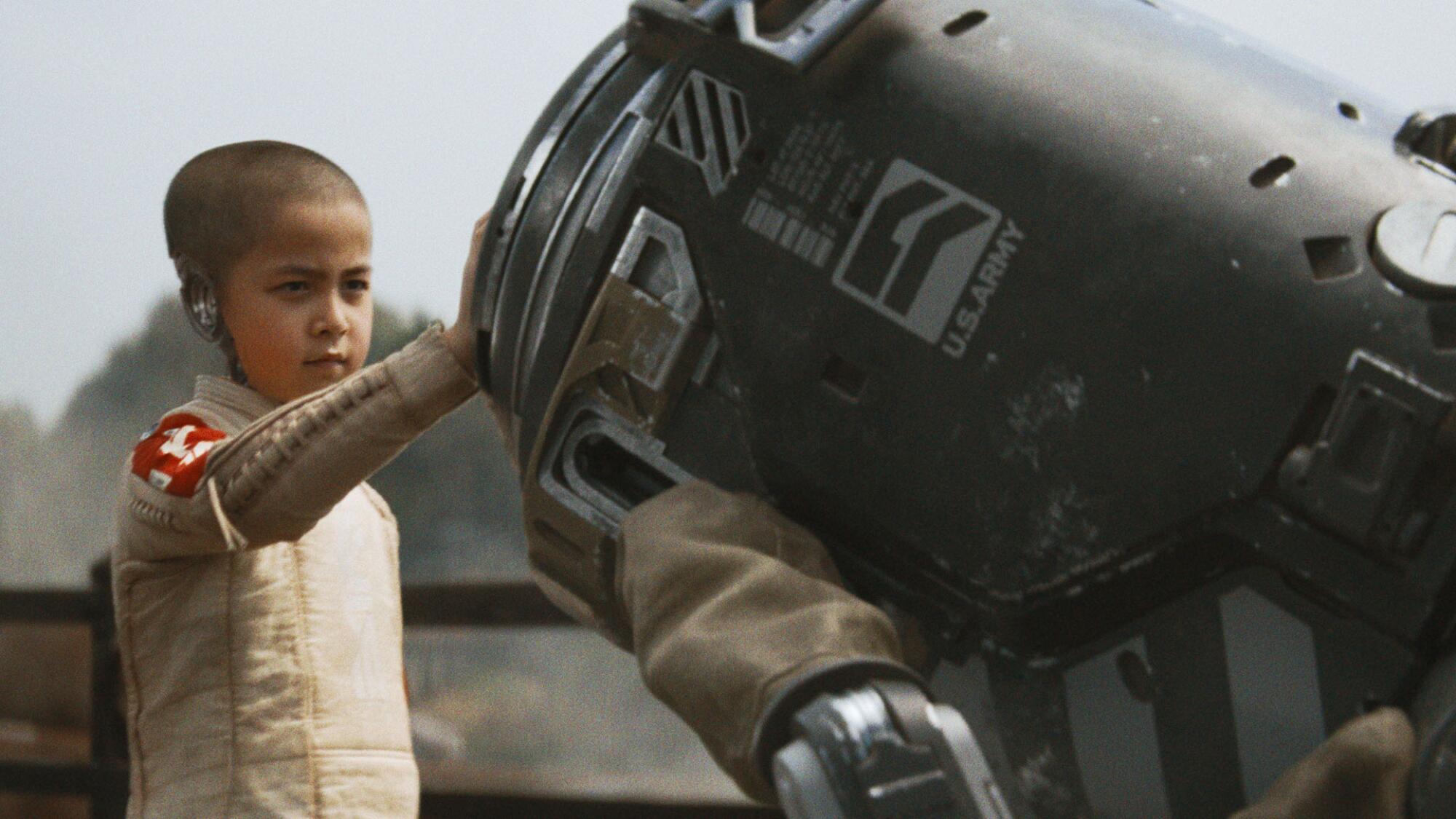
In Gareth Edwards’ 2023 film “The Creator,” a young AI child named Alphie (Madeleine Yuna Voyles) holds the key to humanity’s future.
(20th Century)
In many ways, “The Creator” was the kind of film audiences and critics say they want to see more often out of Hollywood: an original story that takes creative risks, delivering cutting-edge visuals on a relatively lean $80 million. But when it hit theaters that fall, the film opened in third place behind “Paw Patrol: The Mighty Movie” and “Saw X.” By the end of its run, it had pulled in a modest $104.3 million worldwide.
Part of the problem was timing. When Edwards first pitched the film, AI was still seen as a breakthrough, not a threat. But by the time the movie reached theaters, the public mood had shifted. The 2023 strikes were in full swing, AI was the villain of the moment — and here came a film in which AI literally nukes Los Angeles in the opening minutes. The metaphor wasn’t subtle. Promotion was limited, the cast was sidelined and audiences weren’t sure whether to cheer the movie’s message or recoil from it. While the film used cutting-edge VFX tools to help bring its vision to life, it served as a potent reminder that AI could help make a movie — but it still couldn’t shield it from the backlash.
Still, Edwards remains hopeful about what AI could mean for the future of filmmaking, comparing it to the invention of the electric guitar. “There’s a possibility that if this amazing tool turns up and everyone can make any film that they imagine, it’s going to lead to a new wave of cinema,” he says. “Look, there’s two options: Either it will be mediocre rubbish — and if that’s true, don’t worry about it, it’s not a threat — or it’s going to be phenomenal, and who wouldn’t want to see that?”
After “The Creator,” Edwards returned to more familiar terrain, taking the reins on this summer’s “Jurassic World Rebirth,” the sixth installment in a franchise that began with Steven Spielberg’s 1993 blockbuster, which redefined spectacle in its day. To date, the film has grossed more than $700 million worldwide.
So what’s the takeaway? Maybe there’s comfort in the known. Maybe audiences crave the stories they’ve grown up with. Maybe AI still needs the right filmmaker or the right story to earn our trust.
Or maybe we’re just not ready to root for the machines. At least not yet.
Luka Doncic drops triple-double to power Lakers to victory over Heat
Of course Luka Doncic made the one that didn’t count.
On a frigid shooting night when the star guard made just one three-pointer on 11 attempts, Doncic swished a 40-footer on a dead ball that elicited a roar from the Crypto.com Arena.
He instead made his impact in other ways.
Doncic overcame his bad shooting to still collect his first triple-double of the season, notching 29 points, 10 assists and 11 rebounds in the Lakers’ 130-120 victory over the Miami Heat on Sunday. Fellow guard Austin Reaves was also struggling with his shot, making just four of 14 three-point attempts, but rallied for 26 points and 11 assists to just three turnovers.
Although their stars slogged through concurrent off nights, the Lakers (5-2) still shot 50.5% from the field. They tallied 33 assists to 11 turnovers. They won their third consecutive game.
“We did a lot of really good things and it could have been even better if me and Luka would’ve made a shot,” Reaves deadpanned. “But supporting cast and everybody around that played really well.”
Forward Jake LaRavia, who turns 24 on Tuesday, scored in double digits for the third consecutive game off the bench, finishing with 25 points — two shy of his season high — and eight rebounds. He’s averaged 21.7 points per game in the last three games.
Doncic, who missed three games with minor finger and leg injuries, scored 40 points in each of his first three games this season. Only Wilt Chamberlain had ever started a season with three consecutive 40-point games. But Doncic was happy to sacrifice the scoring streak Sunday.
“We get a win,” Doncic said, “[it] doesn’t matter how many I scored.”
Doncic and Reaves struggled in the first quarter, shooting a combined two for seven from the field. Yet the Lakers still led by seven as the star duo combined for eight assists.
Center Jaxson Hayes was one of the main beneficiaries in that span, scoring 11 points on five-of-five shooting. He had a ferocious one-handed dunk off a Doncic assist that got Hayes so amped up that he head-butted the basket stanchion in celebration. He sank his first three-pointer since March 27, 2023, stepping confidently into a shot that put the Lakers up 23-13 and forced the Heat to call an early timeout.
Hayes finished with 15 points and five rebounds in his first start of the year as Deandre Ayton was held out because of back spasms. Ayton’s back flared up during the Lakers’ win in Memphis on Friday, causing him to sit out the entire second half. He was available to return in the fourth quarter, coach JJ Redick said after the game, but with the Lakers feeding off Hayes and Jarred Vanderbilt at center, the team didn’t want to risk further injury.
The Heat (3-3) finished the third quarter on a 20-7 run to pull within four points heading into the fourth quarter. Former UCLA star Jaime Jaquez Jr., playing in front of his hometown crowd, cut the lead to two with an emphatic one-handed put-back dunk 58 seconds in the fourth quarter. A hush fell over the Lakers crowd.
But Reaves helped quell the comeback effort.
He stumbled while trying to dribble behind his legs, but recovered to shoot a fadeaway mid-range jumper with 1.6 seconds left in the shot clock that put the Lakers up by six with 5:13 remaining in the fourth quarter. Less than 20 seconds later, Reaves threw a lob from just inside mid-court to a soaring LaRavia, who brought the crowd to its feet with a two-handed dunk.

Video: Afghanistan’s Blue Mosque damaged in earthquake | Infrastructure
Video shows damage to Afghanistan’s shrine of Mazar-i-Sharif, also known as The Blue Mosque, after a 6.3 magnitude earthquake. Officials in the area say at least seven people have been killed and 150 injured.
Published On 3 Nov 2025
Nine-month-old baby killed in dog attack
A nine-month-old baby has been killed in a dog attack in south-east Wales, according to Gwent Police.
Officers and paramedics went to a property on Crossway in Rogiet, Monmouthshire, at about 18:00 GMT on Sunday.
The dog was seized and removed from the address, the force said.
Police were working to establish the breed of the animal and no arrests had been made.
Ch Supt John Davies said: “Officers are on scene and will be making further inquiries as the investigation progresses.”
Residents said they were in disbelief at the death of the child, with the community in shock and trying to come to terms with what had happened.
They said they saw police cars and ambulances on the quiet residential street in south Wales at the time of the incident.
By 22:00 the police cordon had been lifted and all the ambulances and most police cars had gone, replaced by scenes of crime investigation vehicles.
At this time two police officers were still guarding a house on Crossway, a street now silent but for the hum of cars on the M4 and trains on the south Wales to London line.
‘The silence allows me to hear every flurry of falling snow’: walking in Switzerland’s hidden valley | Switzerland holidays
In the muffled silence all I can hear is the crunch and squeak of snow underfoot. The white path ahead of me meanders skyward through forests of larch and pine, their boughs glittering with snow. When I look back, I can see for miles – an icily beautiful panorama of crags and peaks.
I’m in the Lower Engadine, in remote south-east Switzerland, thanks to a tip shared by my Swiss friend Kaspar, when I was pondering a winter walking holiday away from the crowds. Over two weeks I’ll be exploring this fairytale landscape alone, following well-marked trails.
The Lower Engadine contains few ski slopes, even fewer tourists and Switzerland’s only national park, a fiercely protected 170 sq km of wilderness now inhabited by 36 species of mammal and more than 100 species of bird, including bearded vultures, eagles, wolves, ibex, mountain hares and marmots.
The national park is closed to visitors during the winter, but several Engadine walking trails are close to its borders, meaning anyone can – with luck – spot some of its rare wildlife. The Engadine’s inhabitants speak Romansh (an official Swiss language spoken by less than 1% of the population) and follow a way of life that has barely changed – farmers, shepherds, cheese-makers and, more recently, artists attracted by the extraordinary beauty of this hidden valley.
Without a developed ski scene, it’s all about “slow” tourism here, with small family-run hotels, guided walks and visits to artisanal food producers. “This is a place where Swiss families come to reconnect with nature,” says Kaspar, who has been holidaying here for more than two decades. “In winter that means hiking, snow-shoeing, sledging, travelling in horse-drawn carts, bird-watching and cross country skiing. We come here for peace and quiet, for a reminder of wilderness.”
I base myself in Scuol, the end of the railway line and the largest of the 15 villages in the valley, reached via two connecting trains from Zurich. It is indeed a winter walker’s paradise, with more than 160km (100 miles) of trails kept safely walkable by an army of invisible labourers who spread sawdust on icy tracks and clear paths with snow ploughs while the rest of us sleep.
These routes (known as Winter-Wanderwege) are marked on a free map, available from Scuol’s tourist office (also downloadable to your phone). They’re easy to follow, thanks to an efficient system of numbers, signposts and coloured poles, and can be accessed by regular trains and buses.
I decide to tackle the Engadine Way, a 77km route that runs from one end of the valley (Zernez) to the other (Martina on the Austrian border) and can be completed, comfortably, on a series of day hikes. Each morning I take a bus or train (free with a guest travel pass handed out by hotels) up or down the valley and follow one of the routes to the next bus or train stop to head home, walking between five and 16km a day. I give myself a couple of days to “warm up” by following easy paths beside the River Inn that runs through the valley and cuts through Scuol. I need to get used to walking in crampons, with snow baskets on my walking poles, and prepare for the ascents and descents to come.
I’m delighted to discover that every village contains something to astonish the unsuspecting ambler. In Zernez it’s the National Park Centre, which tells me everything I need to know about the wildlife, geography and geology of the area. In Susch it’s the Museum Susch, an old monastery converted into a stunning art gallery dedicated to female artists (Tracey Emin has her own room), while its chic bistro makes a welcome pit stop for mountain-herb tea and Engadiner Nusstorte – pastry stuffed with caramelised walnuts.
In the villages of Lavin and Tschlin it’s the tiny, gloriously painted churches, while in Guarda it’s a surprise French patisserie (Garde Manger) and a collection of richly decorated houses. In fact, most of the valley’s traditional Engadine houses are flamboyantly decorated – sundials, flowers, animals – using a “scratching” technique known as sgraffito. Several still home cattle and goats in the basement, while the farming families live above, and their chickens roam the streets.
But the walks that leave me the most ecstatic are those that wind deep into the unpeopled mountains – to frozen lakes (Lai Nair and Alp Laisch), or deserted hamlets (Griosch), or remote bistros serving hot chocolate, beer and dumplings (Zuort and Avrona). On these walks, I pass very few people. Deer tracks run ahead of me as my path – neither gritted nor sawdusted – winds through steeply sided forests, past waterfalls to snow-capped pinnacles and crests where bearded vultures and eagles soar in the clear blue sky.
There’s something meditative about walking through snow: it clears the mind like no other landscape. The all-encompassing whiteness absorbs any nagging concerns, leaving me calm and collected. Its luminosity lifts the spirits, its silence allows me to hear every flurry of falling snow, every bird call. Each day I return feeling mentally and emotionally spring cleaned, purged of all brain clutter.
When I need a break from walking, I visit the Tarasp Castle (a 12-minute bus ride from Scuol) with its contemporary art collection, including Picasso and Warhol. I watch a film in a tiny cinema at the Lavin railway station (all films are in English), visit the abandoned bath houses and springs of Nairs – one of which is now a cultural centre (Fundaziun Nairs) – and the ice sculpture park at Sur En.
On one overcast day I take the Bernina Express up to the frozen Lago Bianco – a winter wonderland of such brilliant pristine white it makes my eyes ache. I could have done more: the tourist office organises guided snow-shoeing tours, tobogganing trips, visits to knife-making workshops, cheese farms and local breweries. And for skiers, Scuol’s handful of conveniently situated pistes – behind the station – are “dream runs”, says my friend. There’s also Scuol’s legendary mineral baths – six indoor and outdoor pools including a brine pool – but I’m saving that for next time. (If you visit on 1 March, you’ll experience “Chalandamarz”, a Romansh tradition of chasing out winter when village children parade the streets in costume, singing, ringing cowbells and cracking whips.)
Scuol is without any of the usual hotel chains. Instead, this “slow” town has an immaculate youth hostel (double rooms with private bathroom from 120 swiss francs/£112, dorm beds from £41) and several family-run guest houses. I enjoyed delicious meals on the sunlit terrace of the adult-only Hotel Arnica (where architect-designed double rooms start at around £200 B&B) and creamy hot chocolates in the bar of the Scuol Palace hotel, once frequented by European royalty and luminaries such as the artist Paul Klee and writer Robert Musil.
Today’s royalty and celebrities make for Klosters or St Moritz, leaving quiet, sleepy Scuol and its network of glittering, snow-carpeted trails to the likes of … well, me. Or anyone else wanting a convenient, tranquil and friendly town in which to rest weary limbs after a day in the wintry wonderland of the Engadine.
Annabel Abbs travelled independently, with a travel pass courtesy of Travel Switzerland. She is the author of Windswept: Why Women Walk (John Murray) and The Walking Cure (as Annabel Streets, Bloomsbury). Order your copy at guardianbookshop.com. Delivery charges may apply
Gavin and Stacey icon ‘to sign up for season two of Celebrity Traitors on one rule’
TV fans have been won over by the celebrity version of The Traitors on the BBC – and now it is being suggested that a Gavin and Stacey star could lead the cast of a second season
A Gavin and Stacey icon is being lined up to take part in a second season of The Celebrity Traitors. Welsh actress Ruth Jones is known to millions as Nessa Jenkins on the hit BBC comedy.
Now BBC bosses are keen to bring the star back to screens as herself as one of the stars of an as yet not confirmed second season of The Celebrity Traitors. TV fans have been won over by the glamorous star packed version of the devious game show that is fronted by Claudia Winkleman.
Celebs including Jonathan Ross, Stephen Fry and Celia Imrie have battled to uncover Traitors and avoid banishing Faithfuls during the first season of the show – which is set to reach a conclusion this week. And already fans are looking ahead to who could be in the cast of a second season.
READ MORE: Alan Carr flees UK before Celebrity Traitors final as he fears being ‘most hated man’READ MORE: Tess Daly supported by lookalike daughter as ‘real reason’ for Strictly exit revealed
A source told The Sun: “The celebrity version of The Traitors has been a phenomenal success for the BBC and they’re already approaching stars for the next run. Ruth is one of the names in the frame and she’s been approached about taking part.
“Given the stellar names they secured for series one, the next instalment has to be just as impressive. Ruth would be an incredible addition to the cast if she can fit it into her schedule.”
However, the TV star is said to have one condition on taking part. The source claimed: “Ruth would only consider taking part on the proviso she would be a Faithful.”
The Mirror has contacted representatives of The Traitors and Ruth Jones for comment. Meanwhile, the BBC said they had “No comment” over the speculation.
The Celebrity Traitors has shone fresh light on long-serving stars of the small screen – with reports suggesting Alan Carr could front a new talk show after seeing his popularity surge while taking part in the show. He has thrilled audiences with his treasonous behaviour as one of the traitors.
While rugby star Joe Marler could end up on screens more after impressing audiences – and seemingly figuring out that Alan and Cat Burns are the two traitors on the show.
According to the Mail, BBC bosses have been eyeing him up throughout the series and it reportedly looks as though the broadcaster’s new controller Kate Phillips is keen on him too.
A TV insider told the publication: “The BBC is constantly looking for new talent and the second he stopped playing rugby, there were eyes on him. Bosses knew that getting him on Traitors would be a very good shop window for him and they could test whether or not the viewers would like him.
“As soon as they saw it, they knew he would be someone the British public would adore and they seem to be right.”
They added: “At the same time, he himself is ready for a new career after retiring from rugby. He has long wanted to present from a BBC sofa and The One Show is one of his favourite programmes. To anchor that would be his dream.”
Former Celebrity Traitors contestant Kate Garraway has tipped Alan Carr to win the BBC show. While on Romesh Ranganathan’s BBC Radio 2 show, she said the celebrities asked two questions which they all knew to be true.
And then they were asked if they were a traitor or not. But Alan appeared to look nervous even when answering the question they all knew to be true.
She explained: “The flaw in the plan was everybody slightly flickered, their eyes changed so when you say ‘are you a mother of five’ they just go yes because they’re relaxed about that. But on every single one Alan looked guilty, even on the ones that were true. So therefore I think his thing is that he looks guilty and the more he mucks up and the more he sweats and the more he can’t get out loud I’m a Faithful, then the more it plays in to ‘Alan’s just being Alan’. And I think that’s going to be the genius.”
Earlier in the Celebrity Traitors special, she claimed he could easily win the show. She said: “I think he’s going to win. I don’t know. I’m going to say it now.”
Like this story? For more of the latest showbiz news and gossip, follow Mirror Celebs on TikTok, Snapchat, Instagram, Twitter, Facebook, YouTube and Threads.
World Rally Championship: Will it be fifth time lucky for Elfyn Evans?
The former Seat and Ford driver is part of a Toyota team that have already won the Manufacturers’ World Championship for the fifth year in a row.
And as so often happens in motorsport, Evans’ team-mates are also his closest rivals.
Rovanpera is the youngest ever world champion after winning back-to-back championships in 2022 and 2023.
Now 25 and in his final season before leaving WRC for new challenges, the Finnish driver has already won three rallies this year and will be ready to pounce on any mistakes from his team-mate.
Ogier, 41, is looking to tie Sebastien Loeb’s record of nine WRC titles. The Frenchman has won five rallies this season and led the championship before a crash at last month’s Central European Rally handed the advantage back to the Welshman.
Despite the competition, Evans says relationships are good.
“We all get on fairly well in the team,” he explained.
“Rallying is quite unique in that we’re racing against the clock rather than physically against each other on track.
“That normally means we get on a bit better in the background and the team has a very good atmosphere on the whole.
“Everything is shared among the drivers, so everything is very open and we tend to try and race it out on the stages, so normally we get on pretty well.”
Evans has been competing against the best of the best for years. If he is able to join his team-mates as a world champion the achievement will be monumental.
Fourteen years after his first WRC race he is as close as he has ever been to glory.
Evans will be hoping a journey that started in Dolgellau could have the greatest of endings in Jeddah via Japan.
Sudan slams RSF ‘war crimes’ in el-Fasher as survivors recount killings | Humanitarian Crises News
A senior Sudanese diplomat has accused the Rapid Support Forces (RSF) of committing war crimes in the country’s North Darfur state, as survivors who escaped the city of el-Fasher recounted mass killings and sexual assault by the paramilitary troops.
Sudan’s ambassador to Egypt, Imadeldin Mustafa Adawi, made the allegations on Sunday as he accused the United Arab Emirates (UAE) of helping the RSF paramilitary group in the ongoing civil war.
Recommended Stories
list of 3 itemsend of list
The Gulf state denies the claim.
Adawi’s remarks followed an earlier statement by Sudanese Prime Minister Kamil Idris, who told the Swiss newspaper Blick that the RSF should be tried in the international courts.
But Kamil rejected the “illegal” idea of foreign troops being deployed to his country, which has been ravaged by a civil war between the RSF and the Sudanese army since April 2023.
The calls for action come a week after the RSF seized the capital of North Darfur, el-Fasher, after an 18-month siege and starvation campaign, resulting in thousands of reported civilian deaths. The city was the Sudanese army’s last stronghold in the region.
In the days since its capture, survivors have reported mass executions, pillaging, rape and other atrocities, sparking an international outcry.
The Sudanese government said that at least 2,000 people were killed, but witnesses said the real number could be much higher.
Tens of thousands of civilians are still believed to be trapped in the city.
“The government of Sudan is calling on the international community to act immediately and effectively rather than just make statements of condemnation,” Adawi told reporters during a news conference in the Egyptian capital, Cairo.
The envoy urged the world to designate the RSF as a “terrorist” organisation, as well as condemn RSF “for committing massacres amounting to genocide” and denounce “its official regional financier and supporter, the United Arab Emirates”.
He also said that Sudan would not take part in talks led by Egypt, Saudi Arabia, the United States and the UAE to end the conflict if the latter remains part of the negotiations.
“We do not consider them [the UAE] as a mediator and someone reliable on the issue,” Adawi stressed.
Mass killings, sexual assault
The UAE, however, denies allegations that it is supplying the RSF with weapons.
At a forum in Bahrain’s capital, Manama, an Emirati presidential adviser said that the Gulf state wants to help end the war, and acknowledged that regional and international powers could have done more to prevent the conflict in Sudan.
“We all made the mistake, when the two generals who are fighting the civil war today overthrow the civilian government. That was, in my opinion, looking back, a critical mistake,” Anwar Gargash said.
Egypt, Saudi Arabia, the UAE and the US, as mediators, have all condemned the mass killings and called for increased humanitarian assistance.
As the world’s worst humanitarian crisis further spirals into chaos, residents who managed to escape el-Fasher recalled their harrowing experience.
Adam Yahya, who fled with four of his children, told Al Jazeera that his wife was killed in an RSF drone strike shortly before el-Fasher fell. He said that he and his children barely had time to mourn before they found themselves on the run from the paramilitary group.
“The streets were full of dead people. We made it to one of the sand barriers set up by the RSF. They were shooting at people, men, women and children, with machineguns. I heard one saying, ‘Kill them all, leave no one alive’,” Yahya recounted.
“We ran back and hid. At night, I slowly crept out with my children and crossed the barrier. We walked to a village, where someone took pity on us and gave us a ride to the camp here.”
Another 45-year-old woman in the displacement camp of Al Dabbah in Sudan’s Northern State told Al Jazeera that RSF fighters sexually assaulted her.
The woman, who only gave her first name, Rasha, said she left her daughters at home when the RSF seized the army headquarters on Sunday and went to look for her sons.
“The RSF asked me where I was going, and I told them I’m looking for my sons. They forced me into a house and started sexually assaulting me. I told them I’m old enough to be their mother. I cried,” she said.
“They then let me go, and I took my daughters and fled, leaving my sons behind. I don’t know where they are now,” she said.
“We just fled and ran past dead bodies till we crossed the barrier and reached a small village outside el-Fasher,” she added.
Aid agencies, meanwhile, said that thousands of people are unaccounted for after fleeing el-Fasher.
Caroline Bouvard, the Sudan country director for Solidarites International, said that only a few hundred more people have turned up in Tawila, the closest town to el-Fasher, in the past few days.
“Those are very small numbers considering the number of people who were stuck in el-Fasher. We keep hearing feedback that people are stuck on the roads and in different villages that are unfortunately still inaccessible due to security reasons,” she said.
Bouvard said there is a “complete blackout” in terms of information coming out of el-Fasher after the RSF takeover, and that aid agencies are getting their information from surrounding areas, where up to 15,000 people are believed to be stuck.
“There’s a strong request for advocacy with the different parties to ensure that humanitarian aid can reach these people or that, at least, we can send in trucks to bring them back to Tawila,” she added.
Trump Bars China from Nvidia’s Top AI Chips
U.S. President Donald Trump announced that Nvidia’s most advanced artificial intelligence chips known as Blackwell will be reserved exclusively for U.S. companies. Speaking on CBS’ “60 Minutes” and aboard Air Force One, Trump said, “We will not let anybody have them other than the United States.”
This declaration signals a hard turn in U.S. tech policy, potentially going beyond previous export controls designed to curb China’s access to high-end AI semiconductors.
Why It Matters
The decision could reshape the global AI race. Nvidia’s Blackwell chips are the backbone of next-generation AI systems, from large language models to autonomous weapons. By blocking access to China and possibly even U.S. allies Washington is seeking to maintain a decisive technological lead.
However, the move could also strain trade ties, disrupt supply chains, and challenge U.S. allies like South Korea and Japan who rely on American chips for innovation and competitiveness.
China Hawks in Washington: Applauded the move. Rep. John Moolenaar compared allowing China access to the chips to “giving Iran weapons-grade uranium.”
China: Beijing has remained publicly quiet, though the move will likely be seen as another escalation in the U.S.-China tech war.
Nvidia: CEO Jensen Huang said the company has not sought export licenses for China, citing Beijing’s current unwillingness to engage with Nvidia. However, Huang warned that global restrictions could hurt U.S.-based R&D funding.
Allies: The statement comes just days after Nvidia announced plans to supply over 260,000 Blackwell chips to South Korea’s Samsung and other tech giants now casting doubt over whether those deals will proceed.
What’s Next
The Trump administration may soon issue new export rules formalizing these restrictions. Analysts expect a clearer framework distinguishing between “advanced” and “scaled-down” versions of Nvidia’s chips, determining what if anything can be sold abroad.
The decision also raises the stakes ahead of Trump’s next expected talks with Chinese President Xi Jinping, with AI dominance likely to top the agenda in future U.S.-China negotiations.
With information from Reuters.
Stunning nepo baby Iris Law beams with joy under rainbow as she prepares to celebrate landmark birthday

WELL, arc at you, birthday girl!
Model Iris Law beams with joy under a rainbow as she prepares to celebrate hitting 25.
Iris showed off her toned tum in swimwear on a beach while on hols.
The daughter of actors Jude Law and Sadie Frost wrote on social media: “Last day of 24.”
For Iris, who dated footballer Trent Alexander-Arnold, 27, last year, the sky’s the limit in the fashion world.
We recently revealed how Iris had her assistants running across New York to find her favourite treats ahead of the Victoria’s Secret show.
The model made her debut as an Angel during the return of the world famous runway show in October.
Iris is said to have sent her team of assistants looking for cookies from a particular bakery and then smoothies from another place in New York, according to Daily Mail.
The Victoria’s Secret catwalk show made a stunning return earlier this month and was full of A-list models including, Alessandra Ambrosio, Jasmine Tookes, Angel Reese, Barbie Ferreira, Ashley Graham, Irina Shayk and Emily Ratajkowski.
Iris burst onto the modelling scene when she was in her teens and has been booked by some of the biggest fashion houses in the world.
She has previously posed for Christian Dior, Calvin Klein, and Versace.
She has also started to forge a career in the movies and follow in her famous parents’ footsteps.
Cutter Gauthier, Beckett Sennecke lead Ducks to win over Devils
Cutter Gauthier and Beckett Sennecke each had a goal and an assist, goalie Lukas Dostal made 32 saves and the Ducks beat the New Jersey Devils 4-1 on Sunday night.
Frank Vatrano and Chris Kreider also scored for the Ducks.
Jack Hughes scored New Jersey’s lone goal in the third period, and Devils goalie Jake Allen had 26 saves.
The Ducks have won three straight and five of their last six to move into a first-place tie with Las Vegas and Edmonton in the Pacific Division, an encouraging start for a team trying to snap a seven-season playoff drought. Their 15 points is the most through 11 games since 2014-2015.
The Ducks took advantage of their second straight game against a road-weary Eastern Conference club, outscoring the Detroit Red Wings and Devils by a combined 9-3.
Anaheim scored three goals within the game’s first 22 minutes and dominated the first two periods before New Jersey came to life in the third.
Moments after Allen stuffed Sennecke at the doorstep, Hughes took a pass from Dawson Mercer on a two-on-one break and one-timed a shot past a sprawling Dostal.
But Dostal and the Ducks held off a furious Devils rally in the final minutes, and Kreider scored on an empty netter with 1:54 left to seal the win.
Anaheim scored on its first shot of the game. Sennecke took a pass from Gauthier as he crossed the blue line, shielded New Jersey defenseman Dennis Cholowski with his body as he charged the net and slipped a lunging shot under Allen’s right armpit.

The Ducks made it 3-0 just 1:54 into the second period when Gauthier scored from an almost impossible angle, snapping a left-handed wrist shot from just inside the right goal line under Allen’s left pad for his team-leading seventh goal of the season.
Up next for the Ducks: vs. the Florida Panthers at Honda Center on Tuesday night.
Mississippi homeowner finds missing rhesus monkey

Nov. 2 (UPI) — A rhesus monkey missing in rural Mississippi was found Sunday, according to authorities searching for the last few primates that escaped from a crashed truck hauling nearly two dozen of them nearly a week ago.
The monkey was found by a homeowner on their property in Heidelberg, located about 87 miles southeast of Jackson, the Jasper County Sheriff’s Department said in a brief statement posted to its Facebook account.
The animal is now in the possession of the Mississippi Department of Wildlife, Fisheries and Parks, according to the sheriff’s department, which added that it had no further details about the monkey at this time.
The search continues for two additional monkeys that escaped Tuesday, when a truck transporting 21 rhesus monkeys crashed along a rural stretch of Mississippi highway. Following the crash, the sheriff’s department said three monkeys were still missing.
Authorities initially stated the animals weighed 40 pounds and posed “potential health threats,” as they allegedly carried hepatitis C, herpes and COVID-19.
The Jasper County Sheriff’s Department later recanted this statement, saying that the truck’s driver had stated the animals were infected with diseases, but the Tulane National Primate Research Center, which supplies monkeys to other research organizations, said the primates in question “are not infectious.”
Sinner wins Paris Masters to reclaim world No 1 ranking from Alcaraz | Tennis News
Jannik Sinner’s first Paris Masters crown moves the Italian past Carlos Alcaraz and back into the ATP’s top spot.
Published On 3 Nov 2025
Italy’s Jannik Sinner powered past Felix Auger-Aliassime 6-4, 7-6(4) to capture his maiden Paris Masters title on Sunday, a triumph that catapulted the 24-year-old back to the summit of the men’s rankings ahead of the ATP Finals.
The second seed knew only victory would suffice to leapfrog rival Carlos Alcaraz atop the standings, and he delivered in style to become just the fourth player in tournament history to lift the trophy without dropping a set.
Recommended Stories
list of 3 itemsend of list
For Auger-Aliassime, the stakes were equally high but the outcome crushingly different. The Canadian ninth seed needed the title to secure his spot at the season-ending ATP Finals in Turin, but instead saw his hopes dashed in a high-quality final.
Sinner’s Paris conquest marked his first Masters crown of the year and fifth title of 2025, extending his remarkable indoor hardcourt winning streak to 26 matches.
‘Intense final’
“It’s huge, honestly. It was such an intense final here, and we both knew what’s on the line. Also him, he’s in a very tough and difficult spot, but from my side, I’m extremely happy,” Sinner said in an on-court interview.
“The past couple of months have been amazing. We’ve tried to work on things, trying to improve as a player. Seeing these kind of results makes me incredibly happy.
“Another title this year. It has been an amazing year, no matter what comes now in Turin. I’m extremely happy.”
Sinner made his intentions clear from the opening game, breaking Auger-Aliassime’s serve before consolidating the break as he controlled rallies while the Canadian leaked unforced errors.
Despite the majority of the crowd rallying behind the underdog, Auger-Aliassime struggled to match Sinner’s relentless power and precision.

Sinner untouchable on serve
Sinner proved untouchable on the serve, mixing deep groundstrokes with drop shots and half-volleys to bamboozle his opponent.
The Italian’s dominance was complete in the opening set, when Auger-Aliassime failed to earn a single break point while Sinner dropped just three points on serve, sealing the set with a flourish by firing a cross-court forehand winner.
The second set offered more resistance, however, as Auger-Aliassime showed his mettle, saving five break points.
But even his resolute defence could not crack Sinner’s serving stranglehold as the set headed to a tiebreak.
Auger-Aliassime held his own in the tiebreak until a crucial error handed Sinner the advantage, and the Italian needed no second invitation to surge into the lead.
Sinner then delivered the knockout blow on match point, forcing Auger-Aliassime wide during the rally before unleashing a searing backhand winner down the line to claim his fifth Masters crown.
Auger-Aliassime is set to play this week in Metz, where he had a first-round bye, in a last attempt to secure the final spot at the ATP Finals the following week.

All the people eligible for free bus passes in England, Scotland, and Wales
The age at which you can get a free bus pass can differ greatly depending on where you are based
People across the nation could be in line for additional assistance with their travel expenses, including a bus pass offering free or discounted journeys on local bus services. No matter where you reside in the UK, there is a plethora of schemes designed to make public transport more wallet-friendly, though not everyone will qualify.
Eligibility can vary greatly depending on your location within the UK. For instance, the age at which you can receive a free bus pass can differ significantly if you are located in England, Scotland, or Wales.
Most of the complimentary bus passes nationwide are primarily reserved for the elderly, especially after the government confirmed it will abandon a proposed trial of free bus passes for anyone under 22 in England. As per a BBC report, the government stated that there were no funds available to support the scheme during the current spending review period, which runs until 2028/29.
Continue reading for a comprehensive overview of all the available assistance.
England
In England, pensioners become eligible for a free bus pass when they hit the state pension age of 66, which applies to both men and women. So, if you were born in 1959, you will be able to get your hands on the free bus pass this year.
You can apply for this scheme through your local council under the English National Concessionary Travel Scheme, although the actual name of the bus pass may change depending on where you live.
When applying, you might be asked to provide a passport-style photo as well as a document proving your age and address. However, there is one city in England that has slightly different rules.
READ MORE: ‘I used to hug my brother every day after work – now I have terminal cancer’READ MORE: Gut doctor Megan Rossi issues ‘think again’ alert over common toilet habit
London
Free travel on buses, tubes and other transport is available from the age of 60, but this is only within London. This can be accessed via the 60+ London Oyster photocard which also allows you to get free transport on Transport for London services anytime Monday to Friday, except between 4.30am and 9am.
Further details of free bus travel in England can be found here.
Scotland
In Scotland, once you hit 60, you can get your hands on a National Entitlement Card which gives you free bus travel all over Scotland. However, bear in mind that this Scottish concessionary travel only applies to registered local and long-distance bus services.
So, certain premium-fare services, tours, excursions and group hire services aren’t part of the deal. If you are also between the age of five and 21, you may also be eligible for a National Entitlement Card (NEC) which allows you to access the Young Persons’ Free Bus Travel Scheme.
Further details on free bus travel for older people in Scotland can be found here.. Meanwhile, further details on free bus travel for younger people in Scotland can be found here.
Wales
Within Wales, you may be able to get free travel on buses if you are disabled, aged 60 or over, or an injured service personnel which you can apply for through Transport for Wales. While not free, people aged between 16 and 21 caaan apply for a MyTravelPass which allows them to get up to a third off the cost of bus travel in many circumstances.
Further details of this in Wales can be found here.
With ‘Sinners’ and more, horror could have banner Oscars year
There’s a good chance that a horror movie will be nominated for the 2025 best picture Oscar.
And if Ryan Coogler’s “Sinners” or Guillermo del Toro’s “Frankenstein” make the cut, it will be the first time in the Academy Awards’ 97-year history that a fright film has been nominated in consecutive contests.
It’s long overdue. And if you believe part of Oscars’ purpose is to promote the industry and celebrate its achievements, there’s no better time for the academy to get over its traditional disdain for cinematic monstrosities.
As most other sectors of Hollywood’s film business look precarious — adult dramas, the traditional awards season ponies, are dropping like dead horses at the box office, while attendance for the once-mighty superhero supergenre continues to disappoint — horror has hit its highest annual gross of all time, $1.2 billion, with a good two months left to go.
“Sinners,” released in April, remains in fifth place on the domestic box office chart with $279 million. Its fellow Warner Bros. offerings “The Conjuring: Last Rites,” “Weapons” and “Final Destination: Bloodlines” occupied slots 12 through 14 as of mid-October.
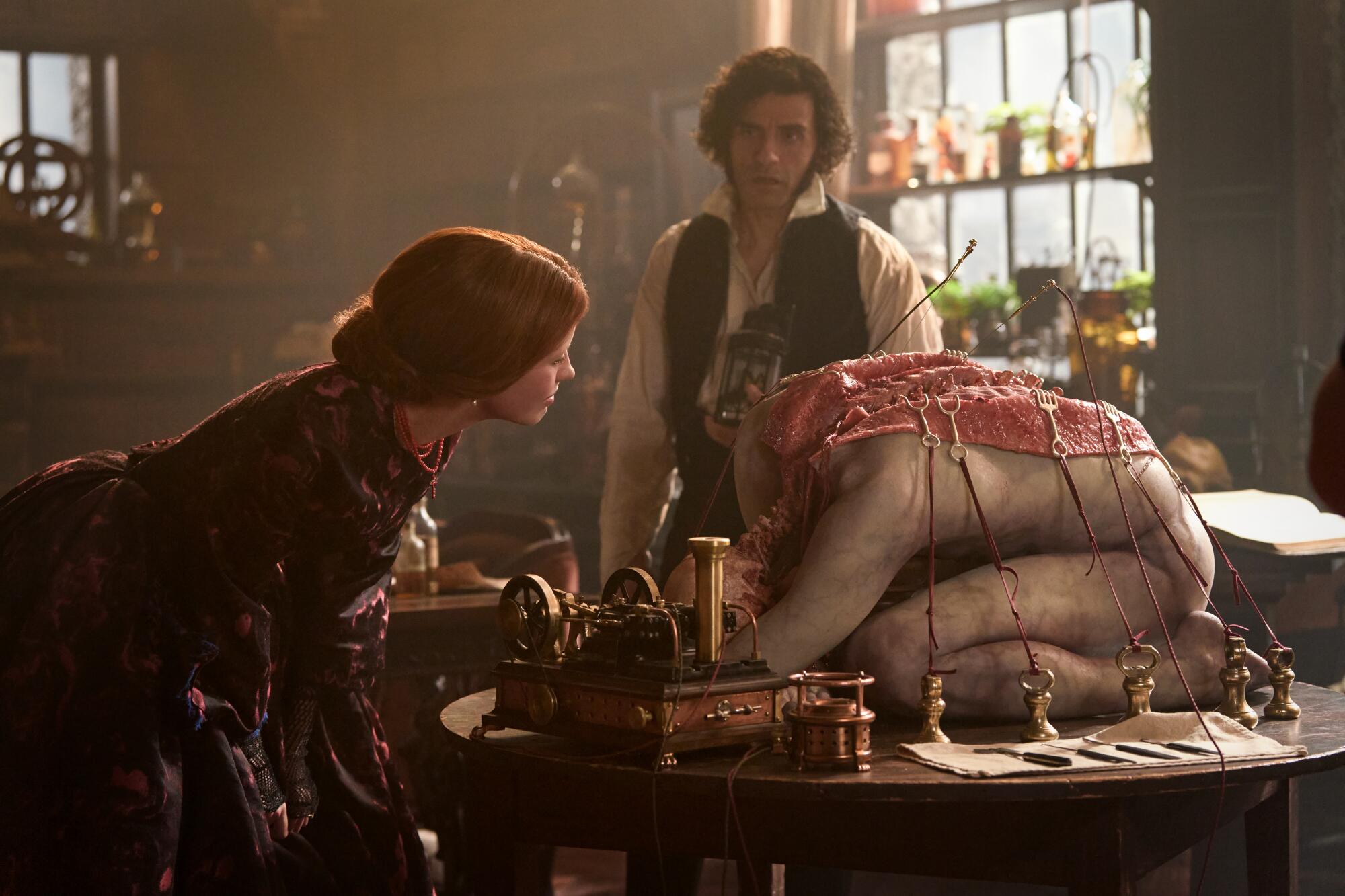
Mia Goth as Elizabeth and Oscar Isaac in “Frankenstein.”
(Ken Woroner / Netflix)
“Horror has been, historically, the Rodney Dangerfield of genres,” notes Paul Dergarabedian, head of marketplace trends for global media measurement firm Comscore. “It can’t get no respect.
“But horror is very important to the industry on so many levels now,” he continues. “We have four horror movies in the top 15 this year, all of those generating over $100 million in domestic box office. And to make a significant scary horror movie, you don’t have to break the bank. Look at [‘Weapons’ filmmaker Zach Cregger’s 2022 breakout feature] ‘Barbarian’; half of that was shot in a basement.” Similarly, compare “Sinners’” $90 million price tag to “Black Panther’s” $200 million.
Horror’s popularity has gone in cycles since Universal’s run of classic monster movies in the early 1930s. But profitability has been a reliable bet more often than not — and Karloff’s “Frankenstein” and Lugosi’s “Dracula” still resonate through pop culture while most best picture winners of the same era are forgotten.
Still, it wasn’t until 1974 that “The Exorcist” received the first best picture nomination for a horror film, and ahead of the success of “The Substance” at the 2025 Oscar nominations the genre’s fortunes had only marginally improved. Indeed, many of the titles usually cited as a mark of horror’s growing foothold in awards season — “Jaws,” “The Sixth Sense,” “Black Swan,” 1991 winner “The Silence of the Lambs” — are arguably better characterized as something else entirely, or at best as hybrids. (To wit, the sole monster movie that’s won best picture, Del Toro’s 2017 “The Shape of Water,” is primarily considered a romantic fantasy.)

Ryan Coogler’s “Sinners.”
(Warner Bros. Pictures)
Fright films’ reputation for delivering cheap thrills to undiscerning audiences was often deserved, but there were always stellar horror films that the academy overlooked. And more recently, films such as “The Substance,” “Sinners” and Jordan Peele’s 2017 nominee “Get Out” have pierced ingrained voter prejudices against the genre by adding social commentary and undeniable aesthetic quality without compromising gory fundamentals.
“The horror genre really does seem to be attracting great directors who are immersed in it, have a real auteur point-of-view and make interesting movies that have horror elements but explore other themes as well,” notes The Envelope’s awards columnist, Glenn Whipp. “‘Sinners’ is Ryan Coogler’s vampire movie, but it’s also about the Jim Crow South and American blues music. How can you resist that if you’re an academy voter?”
And with horror packing in filmgoers like no other genre, high-profile nominations could help the Academy Awards broadcast attract the bigger ratings its stakeholders have been desperately seeking at least since “The Dark Knight” failed to make the best picture cut in 2008.
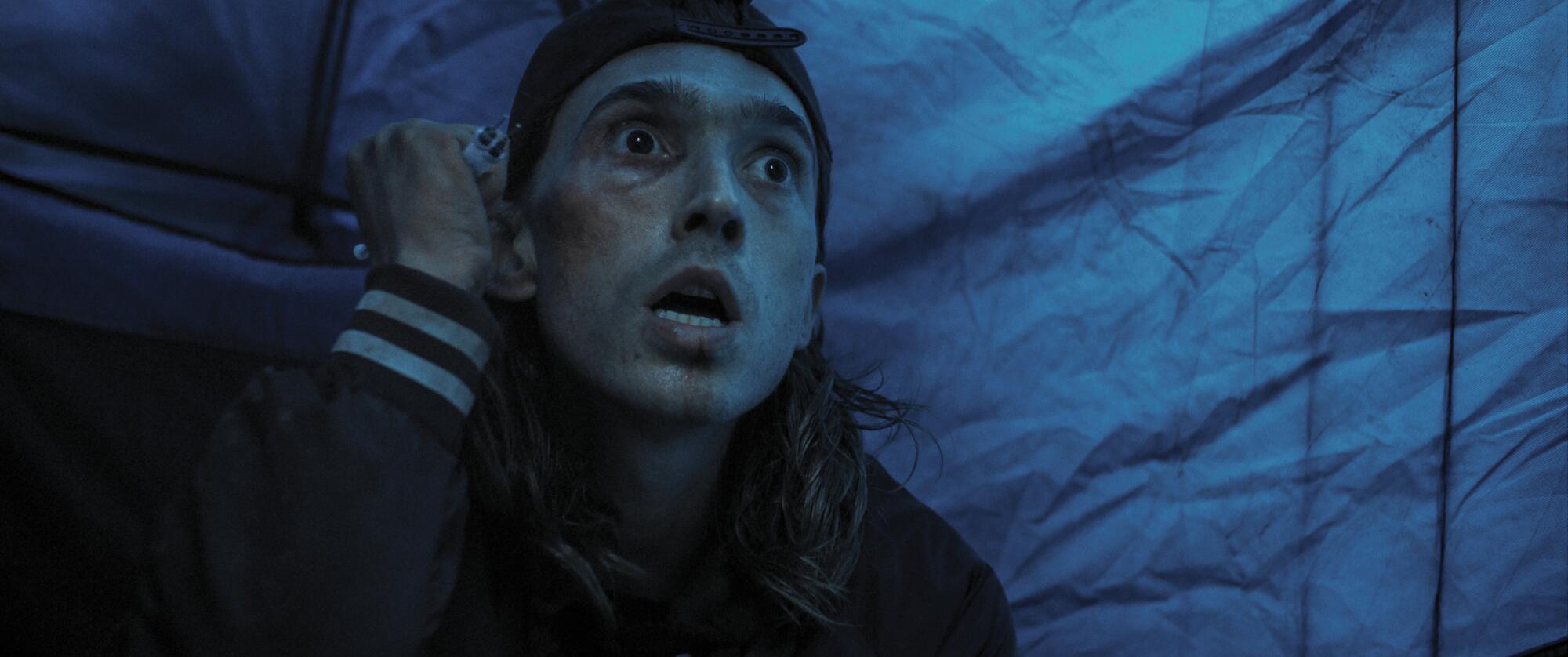
Austin Abrams in “Weapons.”
(Warner Bros. Pictures)
“That was the whole reason we went to 10 potential nominees,” Dergarabedian recalls. “We wanted to have more blockbuster representation at the Oscars. This may be the perfect storm. If I were an academy voter, I would vote for ‘Sinners’ and ‘Weapons.’ I don’t think that’s an overstatement, given the films that have come out this year.”
Even beyond this “perfect storm,” though, Whipp sees a sea change afoot.
“Everything’s an Oscar movie now if it’s well made,” he says. “Studios aren’t really making traditional, grown-up dramas and the academy can only nominate what’s in front of them. Horror is being produced at a rate that is greater than it used to be, and at least two of these Warner movies really landed with audiences and critics. The genre is attracting some of our top filmmakers right now, and that’s something that will trickle down to the Oscars.”
“This is not a blip,” Dergarabedian concludes. “It’s a trend that feels like it’s happened overnight but it’s been a long time coming. Back in 2017 we had our first $1-billion-plus horror movie box office. If they stop making good horror movies it might be a blip, but I think Hollywood should take this and bloody run with it.”












